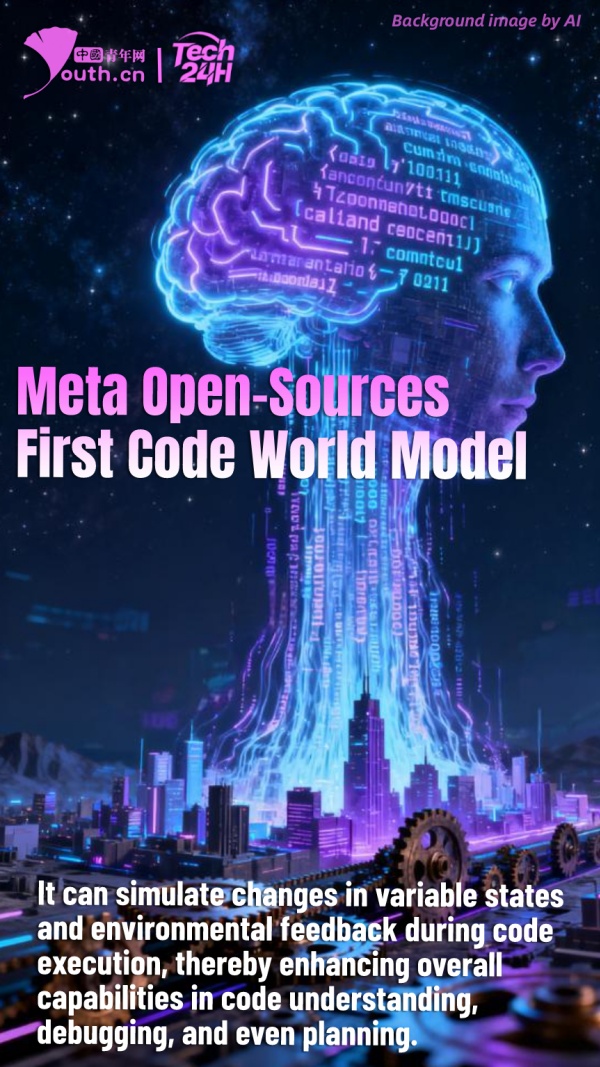Meta’s Code World Model Redefines AI Programming with 131K-Token Context and Execution Tracing

Meta’s Code World Model (CWM) Redefines AI Understanding of Programming
The Next Leap: AI That Thinks Like a Programmer
Meta has announced the release of its innovative Code World Model (CWM), representing a significant step forward in artificial intelligence for programming. Unlike previous AI systems that only process source code as raw text, CWM is engineered to comprehend the actual function and execution of code. By systematically analyzing the step-by-step operation of the Python interpreter and closely observing an artificial intelligence agent autonomously solving engineering problems, it offers a goal-oriented approach to machine reasoning about software development.
At the heart of this technological breakthrough is an architecture that incorporates 32 billion parameters, a scale designed to capture a rich diversity of programming logic and intricate software patterns. The model is built upon an extensive context window of 131,000 tokens, enabling it to retain and leverage a massive codebase or extended debugging session within a single inferential task. This capacity is a substantial leap for operational memory within transformer architectures, facilitating deep, multi-step understanding of projects and reducing the systemic loss of long-range dependencies typical of smaller models.
Through this design, CWM moves beyond the pattern-matching limitations found in many current coding assistants. Instead, it learns execution traces—recording how variable states evolve line by line—and integrates this with agent-centered interactions, such as automated code edits, testing, and shell operations inside isolated software environments. The model’s ability to follow the structural logic of code execution enables a new paradigm for automated software troubleshooting, refactoring, and intelligent code generation.
Understanding the Foundations: How CWM Learned to Reason
Meta’s methodology for training CWM introduces a combination of three advanced machine learning techniques: large-scale pre-training, environment-driven mid-training, and post-training fine-tuning. The pre-training stage drew from a blend of programming language data and general technical literature, giving the model foundational fluency across several coding languages and algorithmic concepts. During mid-training, the focus shifted to immersing the system in direct interaction with real-world code execution—accumulating data from over 200 million Python interpreter traces and multi-million-case agentic solution scenarios.
This uniquely “grounded” approach means CWM doesn’t merely recognize syntax or code patterns; it learns to predict the outcomes of code execution, anticipate variable changes, and spot logical errors as they occur during runtime. It achieves this by tokenizing both natural language and complex code sequences with an expansive vocabulary, strategically incorporating specialized markers to parse reasoning steps, trace computational states, and identify tool usage during the coding process.
The extensive context window also plays a critical role in CWM’s performance. By supporting local and global attention spans, the model maintains a nuanced perspective from immediate code fragments to overarching project objectives. Innovative mechanisms—such as alternating attention blocks—allow the system to efficiently process both granular details and broader context without overwhelming memory or computational bandwidth.
Surpassing the Competition: Benchmarking and Research Impact
CWM’s technical sophistication directly translates into outstanding performance on industry-standard code generation and software engineering benchmarks. Recent evaluations show it outperforms widely recognized open-source models and stands at the forefront alongside top-producing systems in the Chinese tech sector. This evidences its advanced understanding of underlying logic, not just superficial instruction replication, and positions it as a state-of-the-art tool for enterprise and academic research.
Most importantly, CWM’s development is closely tied to advancing reproducible experimentation. The model weights are made freely accessible to the research community under a designated non-commercial license, fostering collaborative exploration of long-context, execution-aware coding, and laying the groundwork for further breakthroughs in AI-driven programming. This openness ensures that independent teams can verify, scrutinize, and extend the technology, accelerating collective progress within the machine learning and software engineering domains.
Researchers can now leverage the released model weights on recognized platforms, integrating CWM into new research pipelines, benchmarking studies, and practical assistive applications such as automated code review, long-context debugging, and next-generation programming aides. The model’s design allows for robust ablation studies and fine-tuning, empowering the testing of hypotheses not only on code synthesis but also on systems reasoning, high-level architectural insight, and practical bug resolution.
Key Specifications and Strategic Relevance
The transformative potential of CWM can be tied to several foundational features:
- 32-billion-parameter architecture for deep representational power
- Dense, decoder-only design with 64 layers, Grouped-Query Attention (GQA), and innovative norms for optimized learning
- Support for up to 131,000-token context windows—far surpassing many industry peers
These attributes equip the model not only for outperforming previous generation tools but also for tackling a new class of challenges within code generation, bug fixing, and end-to-end software development automation. With its ability to “understand” what software computations actually achieve, rather than just echoing code snippets, the system marks a shift toward AI that acts as a cognitive collaborator in complex engineering workflows.
In summary, Meta’s Code World Model ushers in a new era for research at the intersection of machine learning and programming, offering unprecedented depth in both comprehension and application. Its release sets a fresh industry benchmark for how models can learn from code—moving from syntax to semantics—and opens the door for a new spectrum of research on robust, contextually aware, execution-grounded artificial intelligence.
